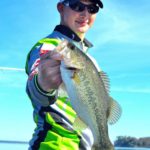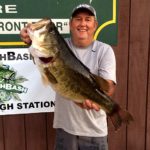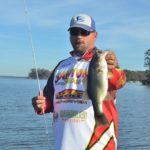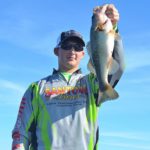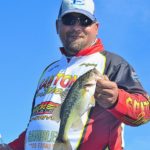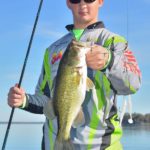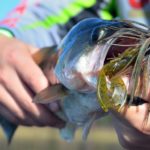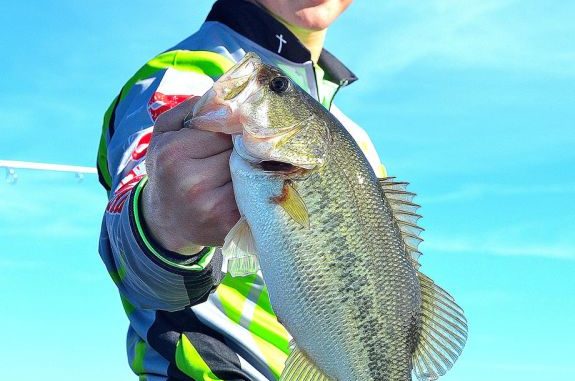
August is the most-dreaded month, but these anglers know the Toledo Bend bass bite can be as hot as the air temperatures. And they share their secrets to success.
Bass fishing in temperatures exceeding 100 degrees is not for the faint of heart.
But those willing to brave the sultry temperatures know August can deliver sizzling bass action — especially on America’s No. 1 bass fishery.
“No doubt, I have extreme confidence fishing Toledo Bend in August,” Erath tournament angler Eric Smith said. “Even in August it’s not uncommon to catch a winning bag of fish weighing 25 pounds,” Smith said.
Another tournament angler, Opelousas’ Kyle Guidry, has another reason to be excited about fishing Toledo Bend thismonth.
“There’s a lot less pressure on the lake,” the 24-year-old said. “In some areas, you may only see one or two boats during the day.
“And without all that pressure, you certainly have the opportunity to catch a lot of bass.”
On the heated surface of Toledo Bend’s late-summer waters, many bass anglers automatically think in terms of catching small schooling bass.
But remember that we are discussing Toledo Bend, where anything can happen even in the dog days of August.
“I’ll never forget a great trip I had at Toledo Bend in August,” Smith said. “It was late afternoon, and I was fishing a ridge in 20 feet of water along a creek channel near Six Mile.
“I was dragging a Santone football jig with a Mister Twister Poc’it Craw trailer on the edge of that channel.”
On one of his first few casts, Smith hauled in a 9.8-pounder.
“Before it turned dark, I actually ended up with five fish weighing 26 pounds,” Smith said. “Unfortunately I wasn’t fishing a tournament that day.”
That meant the four bass taken after Smith’s lunker averaged 4 pounds.
An impressive summer stringer: But that’s Toledo Bend.
Even more stunning is the fact that there were at least four double-digit bass caught last August, according to the Toledo Bend Lunker Bass Program records.
The largest of these was an 11.56-pounder taken on a Carolina-rigged lizard in Housen by Florien angler Malcolm Franks on an afternoon when temperatures exceeded 100 degrees.
“An angler can fish with confidence on Toledo Bend just about any month,” Guidry said. “So bring a lot of water and other hydrating liquids to be able to stand the heat.
“Sun protection is also a must, and it’s not a bad idea to have a towel wetted with cold or cool water to periodically wrap around your neck and head when you’re out there.”
Of course, bass also can suffer from the extreme heat when placed in livewells. So it’s important to keep the aerator going, and the addition of products such as G-Juice will help keep bass healthy.
So we know Toledo Bend offers some great fishing even in the height of summer, but how can you get in on the action.
Following are some thoughts.
Finding the right spots
Eric Smith and Kyle Guidry agree that the best Toledo Bend locations to find bass in August include well-known areas starting at the Indian Mounds and running all the way to the Toledo Bend dam.
“It’s all about fishing flats, points and creek bends in all these locations,” Smith said.
That’s because there is more baitfish activity in that portion of the lake because of the relatively abundant aquatic vegetation south of Pendleton Bridge.
Noticeably missing however are the vast fields of hydrilla that once prevailed in the lake. Many local anglers believe hydrilla growth has been somehow impaired by the high-water levels on the lake especially in the last couple of years.
Hay grass, other green shoreline foliage and deep brush piles are now the main focus for baitfish and bass.
Housen and Six Mile are especially attractive to anglers because they provide drains, bends and creeks that serve as travel routes for bream and shad venturing shallow — especially early in the morning.
Bass hold on the drains’ and creeks’ edges, waiting to ambush baitfish moving from deep water to shallower areas.
Relatively easy access to the Indian Mounds, Housen and Six Mile can be found on the Texas side of the lake at Mid Lake Campground, Fin & Feather Resort and Jack’s 944 Landing.
Indian Creek near the dam also is very popular because it provides clearer, deeper waters favorable for submerged vegetation including emerging hydrilla.
Bass in that area often can be found deep, situating themselves in brush piles and along the contours of submerged creek edges, especially in bends and near underwater points.
Access to Indian Creek is from the Sam F. Collins Recreation site in Texas.
Shallow-water tactics
The traditional schooling bite can be a lot of fun early on August mornings, Erath angler Eric Smith said.
“I have taken many schooling bass in the Housen area and southward near main-lake points and nearby flats,” Smith said. “I’ll fish with larger topwater plugs, hoping to get a few of the larger fish in the school.
“I have taken 3- and 4-pound bass amongst the smaller fish.”
Kyle Guidry said he counts on a topwater frog when schools appear in the flats.
“I will make long casts into the schools with Pro-Z frogs,” the Opelousas angler said. “I’ll also work that frog parallel to lines of hay grass and shoreline grass.”
Smith and Guidry maintain, however, that the topwater bite won’t last long because the oppressive heat will push water temperatures up as the day ages.
Of course, if you are fishing a tournament, the schooling bass run small.
But Smith said there’s one lure he turns to that seems to pick heftier specimen from the schools.
“It seems that swim jigs are pretty selective in getting a larger bass to bite at midmorning,” Smith said. “Most of my early fish taken on swim jigs have come off hydrilla and hay grass lines in 12 to 15 feet of water.”
The angler uses 5/16-ounce Santone Swim Jigs with Gambler EZ Swimmer trailers. His skirt colors of choice are usually bluegill and bluegrass.
His swim jigs are tied to 15-pound Seaguar fluorocarbon spooled to a Duckett reel on a 7-foot-3-inch Duckett rod.
Smith swims the jigs parallel to grass lines, particularly on points and in pockets.
He varies the retrieve.
“I’ll usually let the bass show me how they want me to retrieve the swim jig,” Smith said. “I’ll start out by working it just under the surface on a medium-to-fast retrieve to cover some water.
“If I start missing fish, I will slow it down, pause or even stop it.”
Guidry pairs a 7/16-ounce Santone Swim Jig with a white pearl or bluegill-flash Mister Twister SwimSation trailer.
The angler’s most preferred skirt color is Matt’s blue herren, and he works the jig on a 7-foot-3-inch Big Bear rod. His swim jig will be also tied to Seaguar fluorocarbon spooled to a 13 Fishing Concept reel.
“I’ll fish the swim jig anywhere — shallow or deep — depending on where I locate bass,” Guidry said. “But in the early mornings, I will be casting it along grass lines and hay grass.”
Deep-water bite
The afternoon bite usually moves deep, Eric Smith and Kyle Guidry agreed.
“The bass and baitfish both find a comfortable, cooler thermocline, and they’ll either suspend or be on the bottom,” Guidry said.
But baitfish remain the key ingredient to a good bite.
“You will have to spend some time looking for them,” Guidry said. “You’ll have to watch your electronics closely because when the baitfish move, so do the bass.”
The ability to read electronics is probably the most-important tool for reservoir bass anglers.
“When bass are suspended, you’ll see them on your Lowrance or Humminbird situated below clouds of baitfish and the bottom,” Guidry said.
He often uses a swim jig, but he gets a thrill catching them on umbrella rigs.
“I’ll work an umbrella rig very much like a crankbait,” Guidry explained. “I’ll cast to the sides of the school of baitfish and even sometimes behind them.
“Most tournaments do not allow anglers to use umbrella rigs, so when I fish it I am doing so chiefly for enjoyment.”
Although Smith sometimes uses an umbrella rig, he also casts chartreuse/blue back 6th Sense’s 300DD crankbaits to target the 14- to 19-foot-deep range at which bass usually suspend.
But he is always ready to change crankbaits.
“Suspended bass will hit these crankbaits, but it’s very important you match the depths where the fish are situated with the running depth of the crankbait,” Smith said. “I’ll use the 500DD model when I want to reach 25-foot depths.”
Smith and Guidry said bass also relate to deep brush piles, usually positioning themselves on the bottom.
“Crappie will be sitting in tighter schools, stacked like a tree within and near the brush piles,” Smith said. “And the shad will be illustrated as balls or clouds on your electronics above the brush piles.”
Both of these anglers chiefly rely on jigs when bass are on the bottom in depths ranging 20 to 25 feet.
“I’ll be looking where underwater points intersect deeper ledges on creek beds for brush piles holding baitfish and bass,” Smith said. “If those brushpiles are loaded with baitfish, the bass will be there.
“They’re never far from food.”
Smith uses a couple of jigs when fishing the hard bottoms: either a ½-ounce Santone Wobble Hog with a Mister Twister Flip’n OUT trailer or a ¾-ounce Football Jig with a Mister Twister Poc’it Craw trailer.
“When I am using jigs, I am looking for quality bass,” Smith said. “That Wobble Hog will oftentimes get good bites when I drag it on the bottom.”
Guidry also works Santone swim jigs and football jigs deep, paring them with either Mister Twister Poc’it Craws or BUZZ Bug trailers to catch his quality bass.
He also works a Dominator Rock’n’Roll Swing Jig with a Flip’n OUT trailer.
But Guidry also will pull out a Carolina-rigged Mister Twister HANG 10 worm.
“In August 2015, I remember doing very well on a Carolina rig, with 22 pounds of bass taken on a deep, main-river ledge in Housen,” he said.
When using swim jigs deep, the angler uses a medium-fast retrieve but twitches the bait a couple of times as he reels it in.
“Jerking it every now and then seems to get bass a little something more to react to,” Guidry said.
Even though you have to deal with extreme heat, there is a distinct advantage to staying out in the afternoon, when bass move deep.
“The fish are just not pressured,” Guidry said. “In August, an angler will be able to stay a bit longer on schools of fish because of the lack of other anglers fishing even the many community holes on the lake.
“And like most of us are saying nowadays, anytime is a great time to be fishing on Toledo Bend.”
Don’t underestimate electronics
As Bassmaster Elite pro Kevin VanDam said after his Toledo Bend win in May, electronics might be the most-important tool in being successful when bass head for the depths.
“When working deep waters on Toledo Bend, you have to look for big balls of baitfish,” Eric Smith said. “And you want to use your electronics to key on creek bends near main and secondary points.
“Fishing the structure and brush piles on creek bends are critical to catching good bass for most of the day,” Guidry said.
